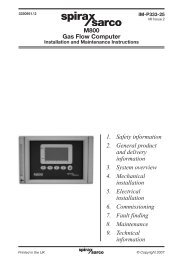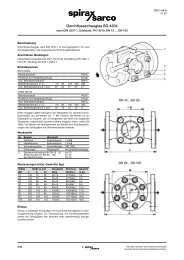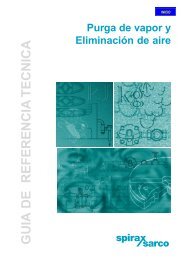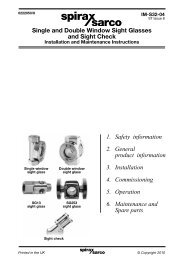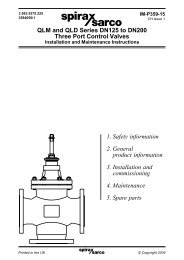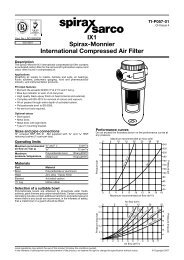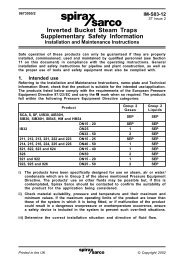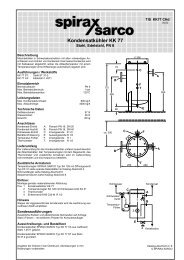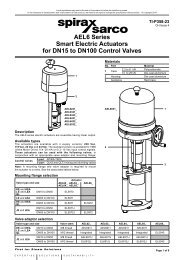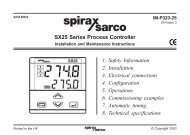2000 Hook-up Book - Spirax Sarco
2000 Hook-up Book - Spirax Sarco
2000 Hook-up Book - Spirax Sarco
You also want an ePaper? Increase the reach of your titles
YUMPU automatically turns print PDFs into web optimized ePapers that Google loves.
Table 23: Heat Transfer<br />
Average Heat Loss from Oil in Storage Tanks and Pipe Lines<br />
Position Oil Temperature Unlagged* Lagged*<br />
Tank Sheltered Up to 50°F 1.2 .3<br />
Up to 80°F 1.3 .325<br />
Up to 100°F 1.4 .35<br />
Tank Exposed Up to 50°F 1.4 .35<br />
Up to 80°F 1.5 .375<br />
Up to 100°F 1.6 .4<br />
Tank In Pit All Temperatures 1.2 —<br />
Pipe Sheltered Up to 80°F 1.5 .375<br />
Line 80 to 260°F 2.3 .575<br />
Pipe Exposed Up to 80°F 1.8 .45<br />
Line 80 to 260°F 2.75 .7<br />
*Heat Transfer Rate in BTU/h ft2 °F temperature difference<br />
between oil and surrounding air<br />
For rough calculations, it may be taken that 1 ton of fuel oil<br />
occ<strong>up</strong>ies 36.4 ft3 . The specific heat capacity of heavy fuel is<br />
0.45 to 0.48 Btu/lb °F.<br />
Heat Transfer from Steam Coils<br />
Approximately 20 Btu/h ft2 of heating surface per °F difference<br />
between oil and steam temperature.<br />
Heat Transfer from Hot Water Coils<br />
Approximately 10 Btu/h ft2 of heating surface per °F difference<br />
between oil and water temperature.<br />
Table 24: Heat Transmission Coefficients<br />
In Btu per sq. ft. per hr. per °F.<br />
Water Cast Iron Air or Gas 1.4<br />
Water Mild Steel Air or Gas 2.0<br />
Water Copper Air or Gas 2.25<br />
Water Cast Iron Water 40 to 50<br />
Water Mild Steel Water 60 to 70<br />
Water Copper Water 62 to 80<br />
Air Cast Iron Air 1.0<br />
Air Mild Steel Air 1.4<br />
Steam Cast Iron Air 2.0<br />
Steam Mild Steel Air 2.5<br />
Steam Copper Air 3.0<br />
Steam Cast Iron Water 160<br />
Steam Mild Steel Water 185<br />
Steam Copper Water 205<br />
Steam Stainless Steel Water 120<br />
The above values are average coefficients for practically still fluids.<br />
The coefficients are dependent on velocities of heating and<br />
heated media on type of heating surface, temperature difference<br />
and other circumstances. For special cases, see literature,<br />
and manufacturer’s data.<br />
Heat Transfer<br />
Table 25: Heat Loss from Open Tanks<br />
Liquid Heat Loss From Liquid Suface Heat Loss Through Tank Walls<br />
Temp. BTU/ft2 h BTU/ft2 h<br />
°F Evap. Rad. Total Bare Insulation<br />
Loss Loss Steel 1" 2" 3"<br />
90 80 50 130 50 12 6 4<br />
100 160 70 230 70 15 8 6<br />
110 240 90 330 90 19 10 7<br />
120 360 110 470 110 23 12 9<br />
130 480 135 615 135 27 14 10<br />
140 660 160 820 160 31 16 12<br />
150 860 180 1040 180 34 18 13<br />
160 1100 210 1310 210 38 21 15<br />
170 1380 235 1615 235 42 23 16<br />
180 1740 260 <strong>2000</strong> 260 46 25 17<br />
190 2160 290 2450 290 50 27 19<br />
200 2680 320 3000 320 53 29 20<br />
210 3240 360 3590 360 57 31 22<br />
Table 26: Heat Emission Rates from Pipes<br />
Submerged in Water<br />
Published Overall Heat Transfer Rates Btu/ft2 Tank Coils, Steam/Water<br />
h °F<br />
(Temperature difference 50°F)<br />
Tank Coils, Steam/Water<br />
100 to 225<br />
(Temperature difference 100°F)<br />
Tank Coils, Steam/Water<br />
175 to 300<br />
(Temperature difference 200°F)<br />
Reasonable Practical Heat Transfer Rates<br />
225 to 475<br />
Tank Coils, low pressure with natural circulation 100<br />
Tank Coils, high pressure with natural circulation 200<br />
Tank Coils, low pressure with assisted circulation 200<br />
Tank Coils, high pressure with assisted circulation 300<br />
Table 27: Heat Emission Coefficients from<br />
Pipes Submerged in Miscellaneous Fluids<br />
The viscosity of fluids has a considerable bearing on heat transfer<br />
characteristics and this varies in any case with temperature.<br />
The following figures will therefore serve only as a rough guide.<br />
Immersed steam coil, medium pressure, natural convection.<br />
Btu/ft2 h °F difference<br />
Light Oils 30<br />
Heavy Oils 15 to 20<br />
Fats* 5 to 10<br />
Immersed steam coil, medium pressure, forced convection.<br />
Btu/ft2 h °F difference<br />
Light Oils (220 SSU at 100°F) 100<br />
Medium Oils (1100 SSU at 100°F) 60<br />
Heavy Oils (3833 SSU at 100°F) 30<br />
* Certain materials such as tallow and margarine are solid at normal<br />
temperatures but have quite low viscosities in the molten state.<br />
67<br />
SYSTEM DESIGN



